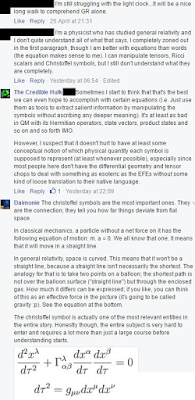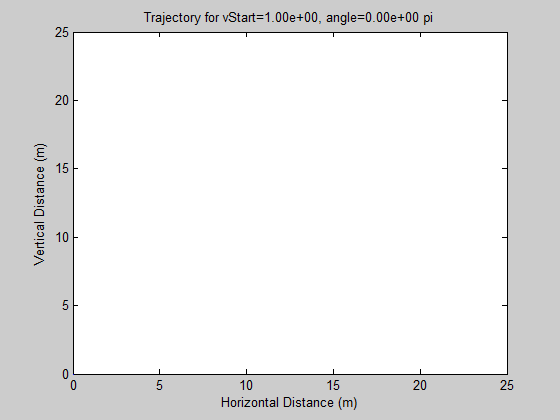General Relativity 101
Introduction
 |
| Screenshot of the conversation that instigated this post. |
The Credible Hulk made a few posts on General Relativity, which is Einstein's theory of gravity. The comment thread to the right (image) ensued.
I have taught myself some general relativity, and I am aiming for a Ph. D. that involves general relativity. Can I explain it, even if slightly?
I think I can, at least, try to do so. So, here I will try to explain the concepts involved:
- Riemann Tensor
- Ricci Scalar
- Ricci Tensor
- Christoffel Symbol
- Energy-Momentum Tensor
- ..
As you can see, general relativity is scary. It really is - one of the standard texts for an introduction course is Spacetime and Geometry by Sean Carroll, and the first four chapters are mathematics.
Yet the information contained does have conceptual explanations. There's a familiar one, involving space as a sort of elastic cloth and planets and stars as really heavy balls that dent the fabric.
However, I also want to provide some concept for the mathematical objects involved. That's the beef of this article.
Let's start with a movie. Had I mentioned it's been a hundred years since this theory was cooked up?
How to scare your readers away
So this is the section where people would typically flee. Mathematics was scary in high school, frightening in university and is just plain horrifying when you've left school.
As a physicist, I no longer see mathematics as something scary. It is a language, and like any language it describes objects and interactions. Instead of focussing on the math, we'll focus on the concepts involved. I will give them their proper name, that is, the mathematical notation.
 |
| An ant is confused on top of a hot air balloon. How did I get here? How did I get so big? |
Let's start with a very, very brief history. Suppose you're an ant on a balloon. Not a big ant on a big balloon as in the righthand image, but a very small ant on a very big balloon. Can you figure out that it's a balloon? How? You can only see the horizon, and everything seems flat; much like a human on the earth.
Turns out you can. A guy named Gauss figured out that you could, and wrote some reasonably sophisticated mathematics to say just that: You only need the surface to find out that it's curved.
Following that, several students, including Riemann got to work. Riemann figured out how to generalise the notion above to an arbitrary amount of dimensions. That gives us the first name, and the first object.
The Riemann Tensor, mathematical notion $R^\lambda_{\:\sigma\mu\nu}$, is a mathematical object that contains all the information about a certain space. So, if you want to describe something happening on a surface shaped like a sphere, then the Riemann Tensor contains that information. The object consists of elements. To visualise that, imagine a drawer. You pull it out, and on its sides there's more drawers. And you pull one of those out, and it contains another drawer. Each drawer is numbered. So, if you're asked to look for the element 2134, you pull the second drawer. Of that drawer, you pull the first; of that one, the third. Finally, the fourth; and that is where this element of the information is. In what we will discuss, we have the three dimensions of space and one of time, so that there are four dimensions in total.
The Riemann Tensor is defined purely in terms of another mathematical object, called the Christoffel Symbol, notation $\Gamma^\lambda_{\mu\nu}$. This one is a symbol, not a tensor. This remark might seem superfluous, but it is important to make the distinction even if the meaning escapes you. So, it is a symbol, not a tensor.
The Riemann Tensor has $4\cdot4\cdot4\cdot4$ elements. That's a lot of elements. What if we want a physically relevant object that is a lot smaller? Well, there's two candidates that are relevant to physics. The first is the Ricci Tensor, $R_{\mu\nu}$, which only has $16$ elements. The Ricci Tensor encodes some information of the Riemann Tensor, but not all of it. It is really the smaller physically relevant object. And from it, we can find the Ricci Scalar, also known as the curvature scalar, notation $R$. This is a number, the simplest mathematical object.
Gravity
You now know that the Riemann Tensor tells you everything about a curved space, while the Ricci tensor and scalar are just smaller objects that contain only a part of that information. I've also told you that the Riemann Tensor is defined in terms of the Christoffel symbol, but I didn't tell you what that means.
The christoffel symbol is what leads to what we think of as gravity. There is an equation, called the geodesic equation, that explains this connection. The equation is for light or other massless objects, and really just denotes the shortest path. However, there might be constraints.
Consider two points on a sphere. What is the shortest path? Is it the blue path, path A, or is it the green path, path B? Both of us know that path A is the shortest path. However, that is if you're free to move. An ant on this sphere can only choose path B, which is the shortest path if you are constrained to the sphere.
In physics, as you might remember, a lot of things move along the past of the least resistance. This is true for all manner of things, and its origins lie in the principle of minimisation of energy. So, the constraint that the ant walks on the spherical surface can probably be realised by a resistance, by a force.
What is that force? Well, for curved space, there is a well known name attached to this resistance. It's called gravity. We have just described how it's not really a force, but a result of the surface, of the space, being curved. Gravity is the fictitious force felt because space is curved.
But how does all the weird mathematics come into this? Well, the christoffel symbol is involved in the geodesic equation, which is one of two equations that we will describe:
$$\begin{align} \frac{d^2x^\mu}{d\lambda^2} &= - \Gamma^\mu_{\rho\sigma} \frac{d x^\rho}{d\lambda}\frac{d x^\sigma}{d\lambda}\end{align}$$
 |
| Light is bent by gravity, an effect that serves as empirical evidence and is used in astronomy to observe far-away objects. |
The term on the left is just the acceleration. Newton says that mass times acceleration equals force, so the term on the right is the force; gravity. This tells you that light, which moves along geodesics, is bent by gravity. This effect is used in astronomy, and serves as part of the experimental evidence for general relativity.
Mind you, the entire list of objects above is zero for space that is flat. So, in flat space, a geodesic is a straight line. This is why it took so long to think of general relativity; we could not locally find any evidence of curvature.
In space that is almost flat, we can use physicists favourite trick and use perturbation theory. Perturbation theory can greatly simplify complicated problems. For instance, the simple solutions for a music string are found using perturbation theory. The idea is that, because the space is almost flat, we can take the flat-space solution and then try solutions that are only slightly different.
Guess what that gives you in almost flat space? The answer is, of course, Newton's description of gravity. This should come as no surprise; we live in almost flat space, so the minimum requirement for the theory is that it reproduces those results.
There is one object that I've neglected to mention. It is called the metric tensor, and it is actually more fundamental than the Christoffel symbol. The latter is in fact derived from the metric tensor. There are a number of ways to think about the metric tensor. The one that I find most striking is that the metric tensor tells you how time passes for an observer on the object, which is called proper time. Additionally, the metric tells you about angles, areas and volumes.
Now, we are ready to write down Einstein's field equation:
$$\begin{align} R_{\mu\nu} - \frac{1}{2} R g_{\mu\nu} + \Lambda g_{\mu\nu} &= 8 \pi G T_{\mu\nu}\end{align}$$
These are called the Einstein Field Equations. But what does it tell you? Well, the objects on the left are the Ricci Tensor, Ricci scalar, the metric and the cosmological constant $\Lambda$. Interestingly, Einstein originally thought that including the latter was his biggest mistake, but more recent research on dark energy/matter has made it clear that he was correct. Some interesting communication between Einstein and Schrödinger even hinted at this. All of these have to do with curvature. On the right, we have the energy-momentum tensor times the gravitational constant $G$, which describes the strength of gravity. This object is pretty close to its name; it is a mathematical object with components that describe how matter or energy is distributed and how it flows. Two of the fairly common examples are dust, which has no pressure, and a perfect fluid, which does.
But that is an astounding equation; it tells you that mass shapes spacetime. And spacetime influenced the motion of that mass, which shapes spacetime. We can immediately see that solutions in general relativity are hard - the interaction never ends!
I've always found the model of light bending around heavy objects as the most helpful mental tool. It allows you to imagine a thin line of light bending, thus mapping the space for you.
If I'm not mistaken, then with some difficulty you are now able to identify the components of the Einstein Field Equations. What's more, you know that this tells you how the metric changes, which tells you how the christoffel symbol changes, which describes gravity.
Before we finish, I'd like to discuss two more things. The first is one of the eldest results, the orbit of Mercury. The second is a recent result, the discovery of gravitational waves.
Schwarzschild and Mercury
 |
| Mercury's advancing perihelion. Mercury's orbit is not an ellipse, as Newton's gravity predicts, but is a flower petal shape - as Einstein successfully explained. Source: Scientific Explorer |
One of the first symmetric objects you can imagine is probably a sphere. A sphere is maximally symmetric; it looks the same from all sides. A curved space can have a similar property, and this leads to the notion of the Schwarzschild solution. This is "just" the perfectly spherical solution to Einstein's Field equations . It also leads to a prediction of black holes.
Consider the gravitational field of the sun for an object that comes reasonably close. That object travels through vacuum and we assume it is not heavy enough to affect the sun in turn.
As a result, the effective gravitational potential includes terms of a higher order in the distance from the sun than it does for Newton's gravity. This is most pronounced for mercury, because it is both the closest to the sun and comes very close at one time in its orbit. It probably no longer surprises you when I tell you that mercury's orbit did not agree well with Newton and that Einstein did completely explain its orbit. See also the picture to the right.
Gravitational waves
If we turn to the physicists favourite trick, perturbation theory, and apply it to Einstein's Field Equations, we would find that Einstein's equations are wave equations. Wave equations are a class of equations that are similar to waves; as a result, they allow wave solutions.
Which means that Einstein's gravity predicts gravitational waves. Note that gravity waves are something completely different, and have to do with atmospheric waves. But how to measure them?
Well, as you probably know, physicists at LIGO have succeeded in that measurements, and it would be a shame not to include one of their promotional videos.
Well, as you probably know, physicists at LIGO have succeeded in that measurements, and it would be a shame not to include one of their promotional videos.
That's awesome. If someone asks you what a gravitational wave is, then first answer that its a ripple in space time. It sounds awesome, but is still vague. If they continue asking, speak about a periodic bending of light away from straight lines.
Conclusion
Let's consider what we've described. We started with a vague notion of curvature, and discovered that this information is in the Riemann Tensor. We described smaller, less informative objects called the Ricci tensor and Ricci scalar. We spoke about how gravity bends light, by a certain amount described by the Christoffel symbol, which also happens to describe gravity. We spoke about the metric, and how it defines the Christoffel Symbols. In short, we described a load of mathematical, scary terms that somehow have to do with Physics.
If I've succeeded at my purpose, there is now some concept for each entity in Einstein's Field Equations and of gravitational waves. That'll have to do; Master courses in general relativity take about 180 hours, which isn't enough to do anything useful with it.



